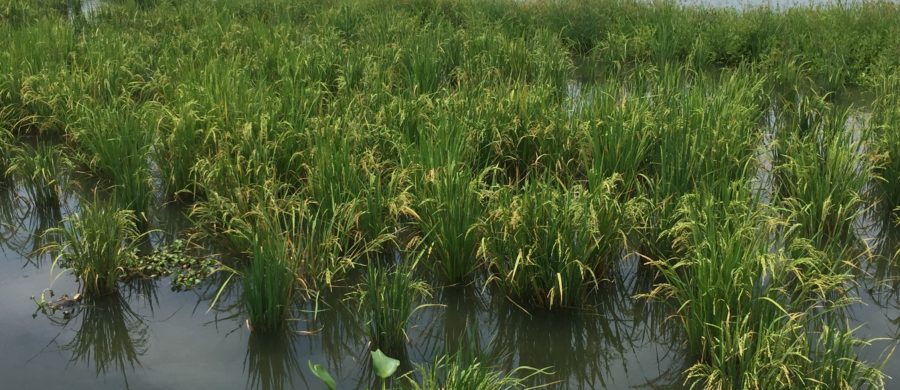
Farmlands of Gold
Technology’s Stories vol. 9, no. 1 DOI: https://doi.org/10.15763/jou.ts.2021.03.23.04
“I will continue cultivation of pokkali while I can. This rice is natural and uses no chemical fertilizers. New generations might not take up this kind of arduous labor. There are changed ways of living now; in earlier times, cultivation was part of our lives; it was an integrated ecosystem, but now there are challenges in cultivation and processing as well as variations brought about by changes in lifestyle”.
Introduction
These words from one of the members of the Women’s Group we met at a village in the Ernakulam district of Kerala succinctly summarizes the tenuous status of pokkali agriculture today. Pokkali rice is a traditional rice variety grown in the coastal wetland zones of Kerala (across the districts of Ernakulam, Alleppey, and Thrissur). Both the variety and its mode of cultivation are understood as traditional because pokkali cultivation is one of the oldest surviving traditions of rice cultivation in South India.[1] Pokkali cultivation alternates rice growing and prawn production on the same land. Farmers cultivate rice from June to October when salinity is low and shift to prawn cultivation from November to May as the salinity of the water increases. It is an organic rice cultivation system; the prawn’s excreta becomes the manure for rice cultivation, while the stubble of the paddy becomes fodder for prawn. This form of rotating rice/prawn production is a treasure trove of traditional knowledge and practices and produces a unique and uniquely productive ecosystem. Formerly it was practiced across as many as 25,000 hectares of the Kerala coast. It is now reduced to 7000 hectares, although less than one-third of this area is now under cultivation.[2] For all of its appeal, pokkali cultivation is now in jeopardy. Yet it still has much to offer a world facing climate change and negative consequences of contemporary chemically-enhanced agriculture. This article explores the challenges pokkali cultivation is facing, and how it may yet survive.
The Unique Practice of Pokkali-Prawn Cultivation
The farmers we interviewed outlined the processes that ensure the viability of this unique form of rotating production: preparing land, producing and maintaining supplies of seed, and regulating water distribution to the farmland from backwaters.[3] Each involves labor-intensive processes such as
- the maintenance of bunds (the raised edges around rice fields) and sluice gates (see Figures 1 and 2)
- the repair and rejuvenation of bunds(chira vettuka),
- making the mounds on which seeds are sown[4],
- the conditioning and sowing of seed,
- harvesting and drying the crop,
- maintaining security and electricity supply. (Farms are lit during late night and early morning).
Cooperation and efforts to build trust among farmers are essential to ensure that cultivation is successful and none of these elements are disrupted. Some of the veteran cultivators of this unique ecosystem whom we had met during the field survey underscored the importance of cooperation and trust:
“The sluice gate is often shared among farmlands. It is quite possible that they cater to more than one or two farmers’ land. Thus, there needs to be a great level of understanding and trust among these farmers, especially in drying the land for Pokkali cultivation after the harvesting of prawn (around mid-April) as well as to maintain the regulation of water during Pokkali cultivation.”
In fact, the operation of a sluice gate (see Figure 3) to regulate water is crucial in the first four weeks of germination. The farmers take extreme care to ensure that water levels are properly maintained between the mounds and that excess water is drained. These steps are necessary to reduce the salinity of the soil. To further accelerate desalination, fresh sweet water is allowed through the sluice as the monsoon progresses. The seeds are pre-treated before being sown by soaking them in water twice, to aid germination. Any interruptions to the monsoon can lead to disruptions in this pokkali seed processing.
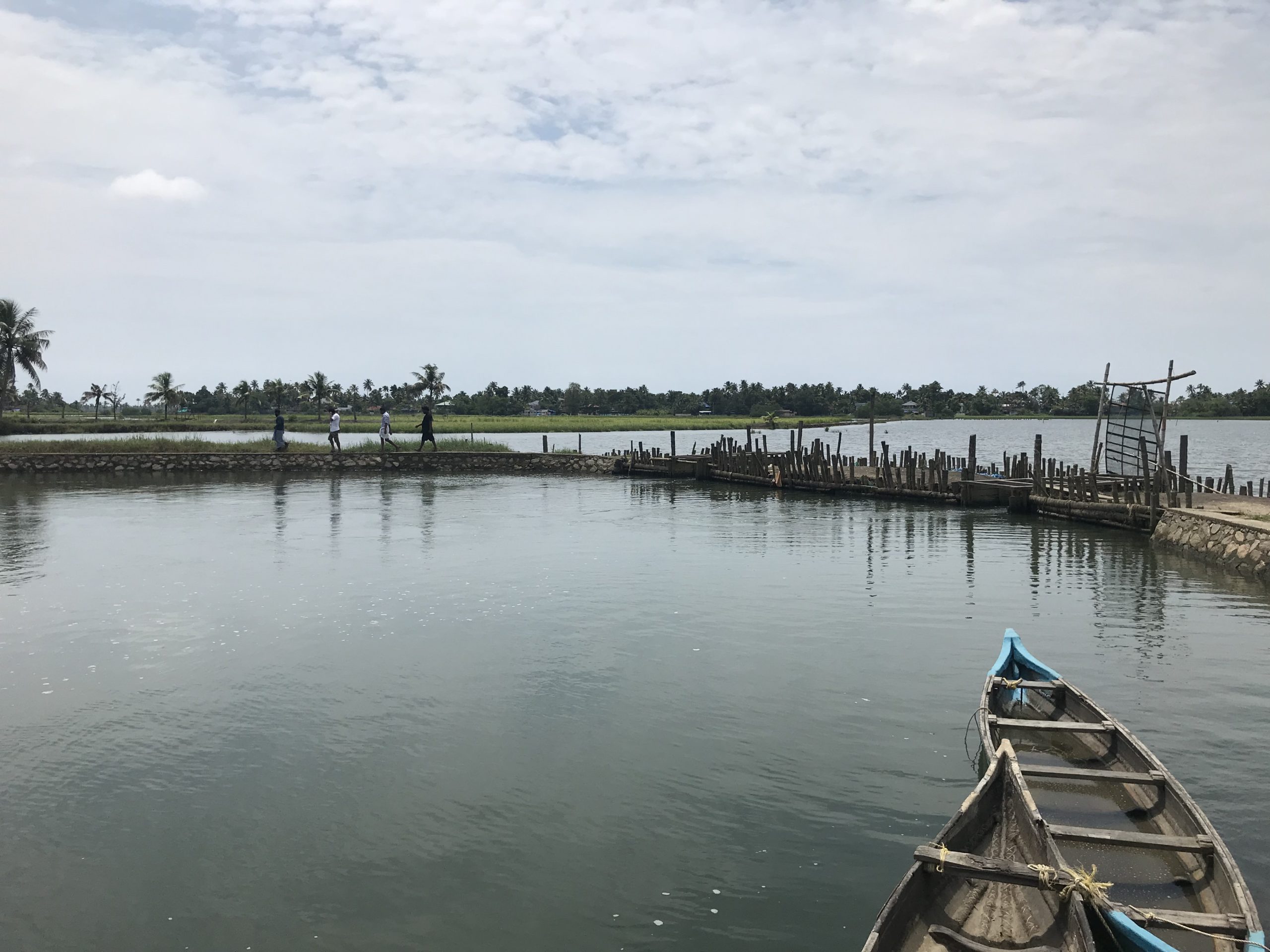
Figure 3. Sluice gate. Image by author.
The name Pokkali derives from the fact that this rice variety stands tall in the wetland fields (“pokkam” means tall in the Malayalam language) (see Figure 4), while it lodges, or falls over, towards harvest time (see Figure 5). When the time comes for harvest, laborers, mostly women, stand knee-deep for long hours in the marshy land to harvest the paddy (see Figure 6). Harvest requires knowledge and skill – working in the marshy land is tricky and requires experience to do well and to avoid harm from the sharp edges of the paddy. Farmers note that only those familiar with Pokkali cultivation can properly harvest the crop. The laborers harvest only the top portion of the paddy, leaving the stalk behind. The harvested paddy is then transported, often by laborers themselves or on small boats, to be dried and sent to a mill for de-husking.
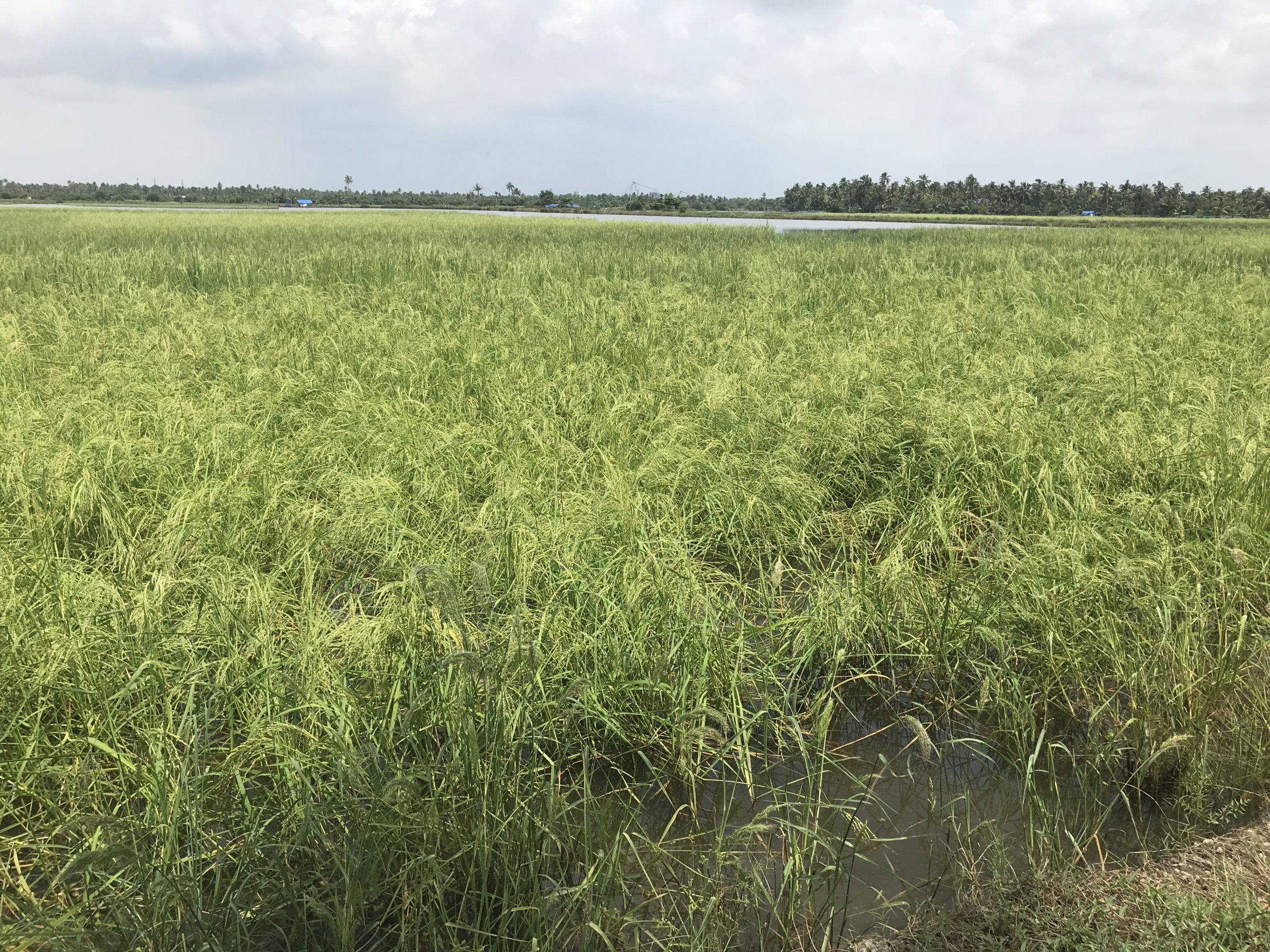
Figure 4. Pokkali rice in the field.
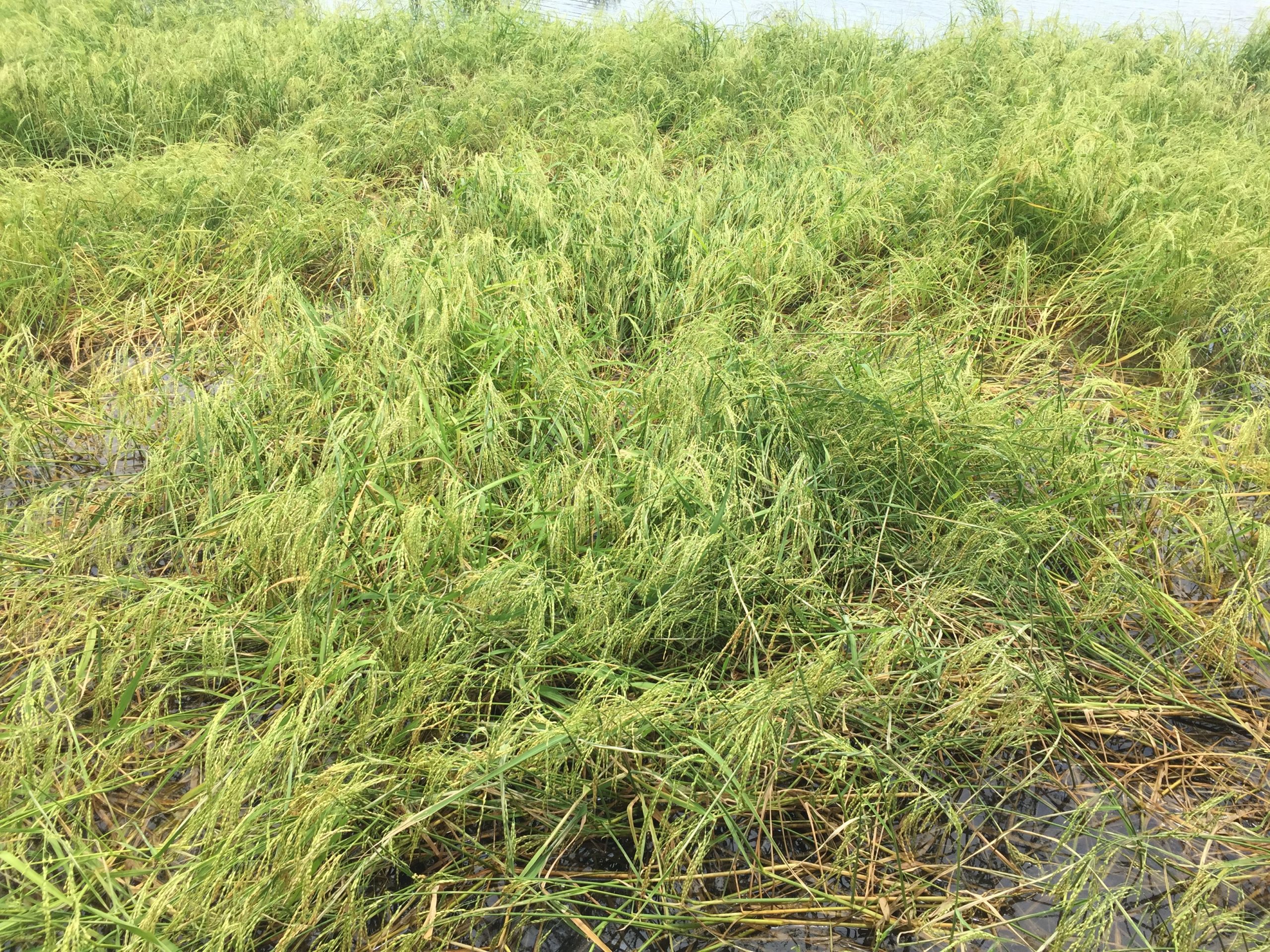
Figure 5: Pokkali rice which has lodged.
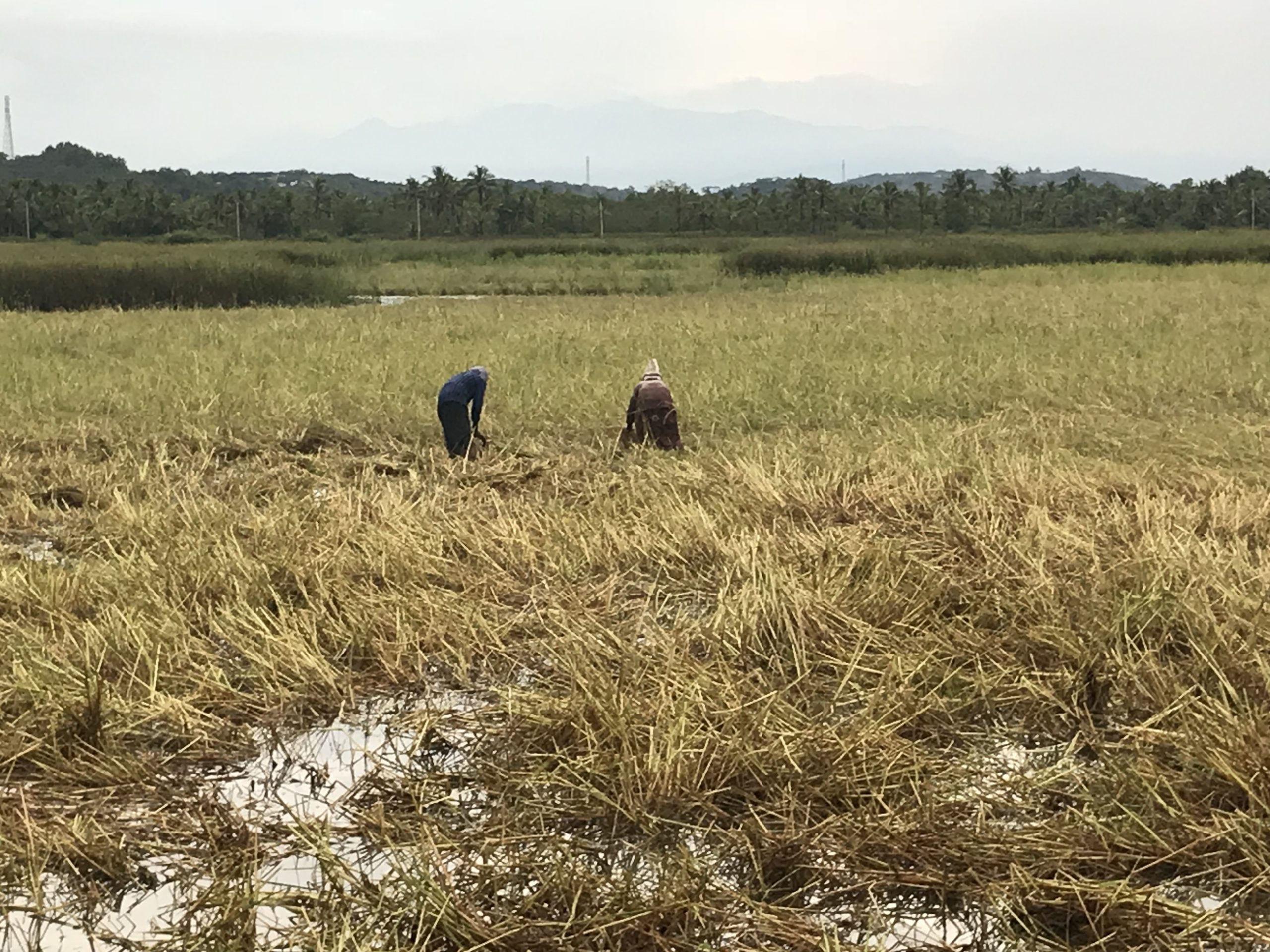
Figure 6: Women harvesting pokkali rice.
After the mid-October pokkali harvest, farmers turn to prawn cultivation. The farmers are required to obtain a “filtration license” from the Kerala State Government’s Fisheries Department. This license enables them to use water from public water bodies for aquaculture. They then strengthen the bunds, undertake repairs of sluice gates and dig channels within the fields leading to the sluice pits. By mid-November, depending on the tidal flow, farmers open and close the sluice gates, allowing saline water to enter the field during high tide and flow out during low tide. A conically shaped net with an opening at one end fixed inside the sluice gate ensures that the young prawns flow into the fields along with the water. Farmers install hurricane lamps to attract prawns during the night. After the tide, farmers remove the nets and affix a bamboo screen to prevent the prawns from flowing out. Farmers also make sure that 30 cm of standing water is retained at all times during this period.
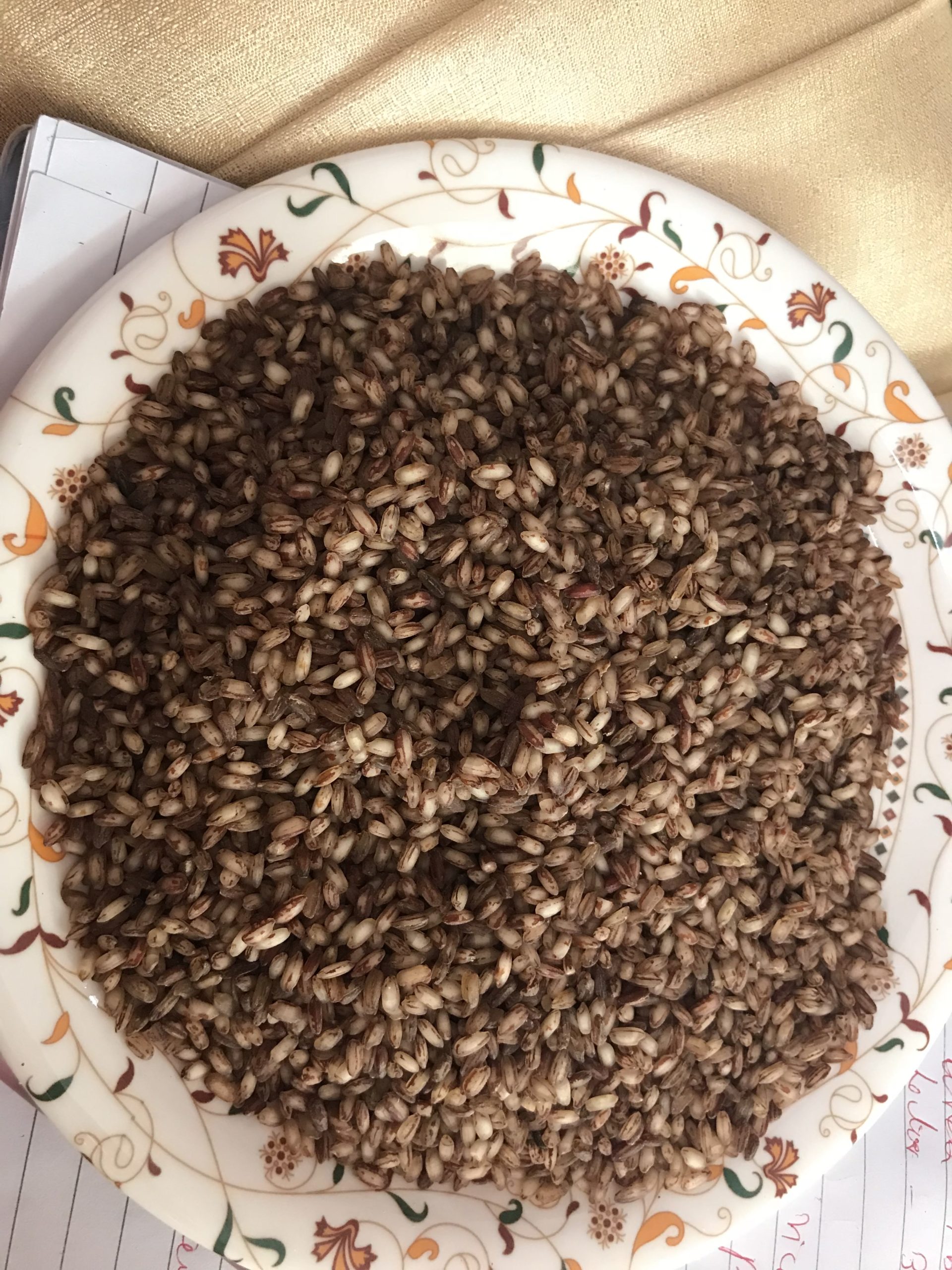
Figure 7: Unpolished pokkali rice.
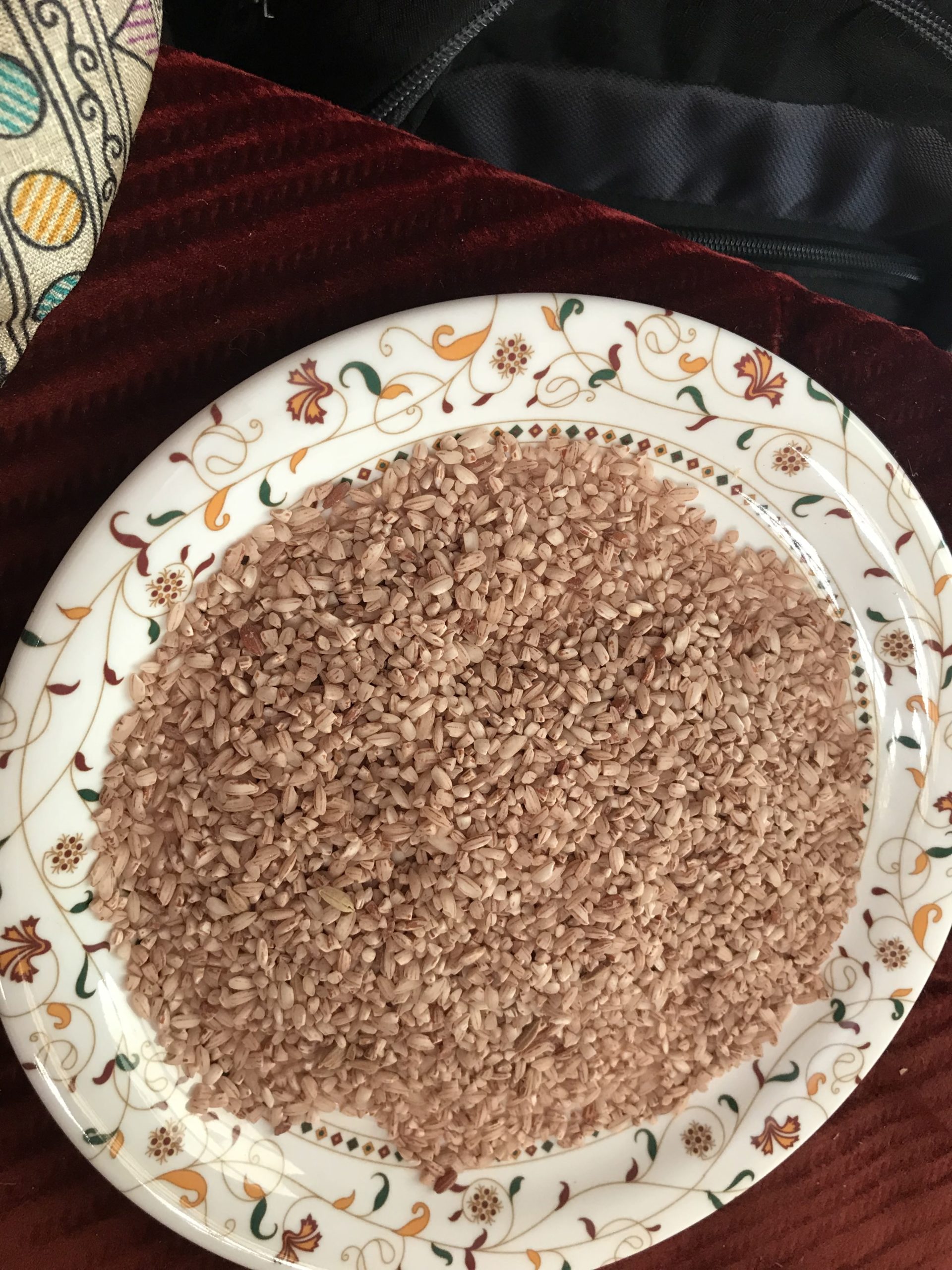
Figure 8. Polished pokkali rice.
After the pokkali harvest, the rice in paddy form is sold to cooperative societies and mill owners, although a significant proportion is kept aside for consumption by the farmers themselves.[5] The rice is consumed both in unpolished and polished form (see Figures 7 and 8).
It is also transformed into value-added products including rice powder (see Figure 9) which is used to prepare several local dishes such as puttu (a cylindrical steamed rice cake). Individuals purchase pokkali rice in these various forms from mills or through local retail stores. Pokkali rice offers numerous benefits for consumers. Because no chemical fertilizers or pesticides are used or needed, pokkali is organic. Studies have found that it has medicinal properties, is high in antioxidants, and low in carbohydrates.[6]
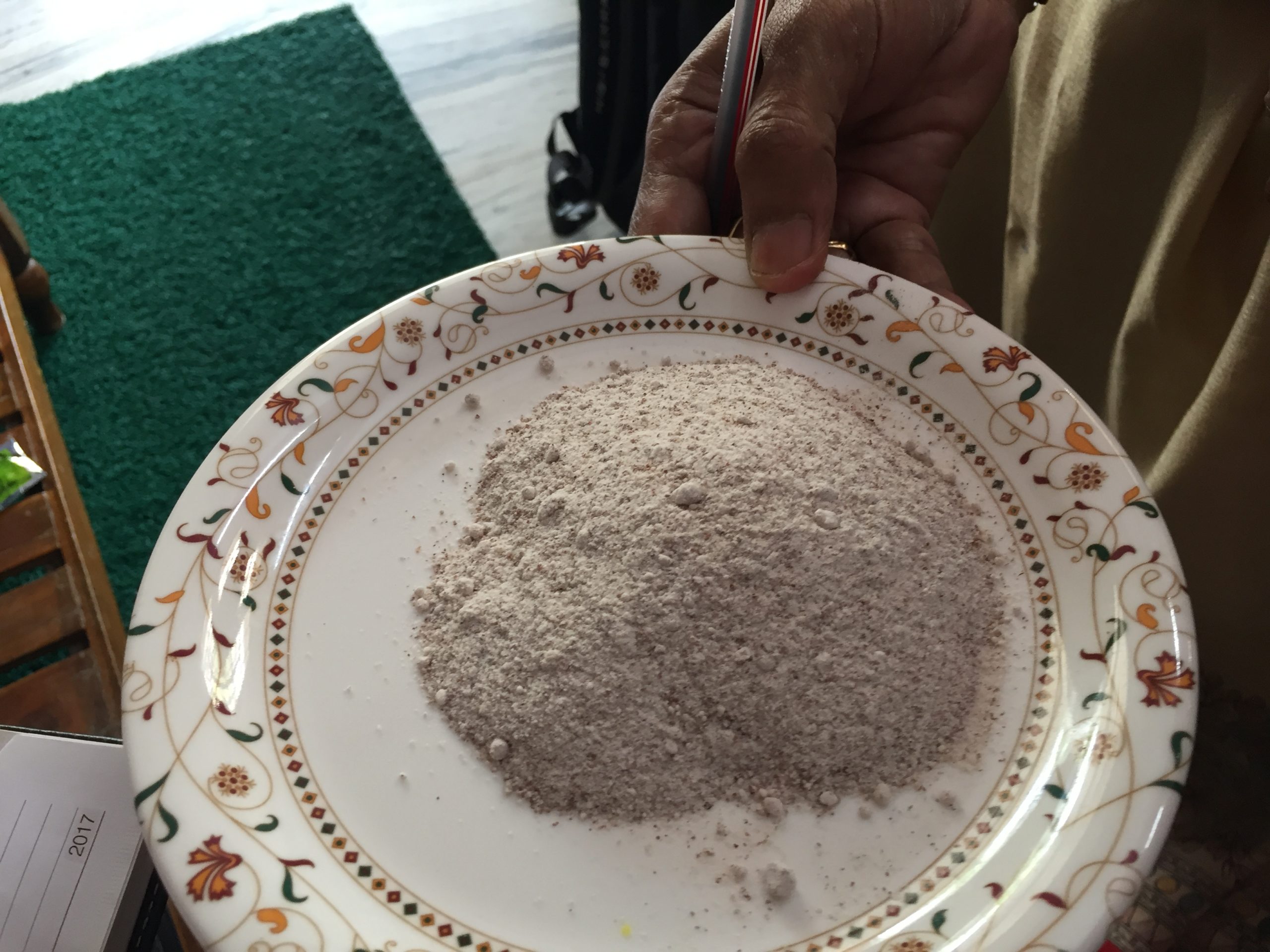
Figure 9. Rice powder.
Just as importantly, pokkali cultivation offers environmental benefits. It uses land sustainably and helps to maintain biodiversity. Scientists and farmers are quick to point out pokkali’s flood resistance. The floods of 2018, touted as the biggest in a century, devastated several cities in Kerala, but the pokkali crops were more or less unaffected.[7] Furthermore, the rotation of pokkali and prawns maintains a symbiotic relationship between farm and yield. The stubble of pokkali becomes the feed for the prawn and the excreta and other organic waste from prawn cultivation form the fertilizer/manure for pokkali cultivation. This rotation ensures a balance of use and production that protects the environment. Farmers are aware that prawn cultivation alone may lead to ecological imbalances and biodiversity degradation. For this reason, they embrace pokkali cultivation and cooperate with the mandatory requirement to procure filtration licenses from officials (to engage in prawn cultivation). Regular check-ups by inspectors from the Fisheries Department cross-verify the validity of such licenses.
Challenges to Traditional Pokkali – Prawn cultivation
Despite its benefits, the escalation of costs and the non-remunerative price of the paddy threaten the economic viability of pokkali-prawn cultivation. The labor intensiveness of the processes pushes costs upwards. The price per kilo of pokkali rice for consumption is near $1.50, almost double that of non-pokkali varieties. In a survey of 154 farmers in November 2018 (see note 5), we found that the total cost of cultivation of Pokkali per hectare stood at $886 while the income received was only $178. For prawn cultivation, the total income per hectare stood at $2218 versus the costs of $1057 per hectare. Pokkali-prawn cultivation, therefore, has only slender profits.
Labor is also a challenge.
“There have been instances where some of the farmers do not engage in harvesting the paddy since they are unable to find enough hands to help, as well as the fact that it is very costly. So they would rather prefer to leave it to decay in the farm such that they can engage in prawn cultivation at least, given such conditionality for obtaining the license for prawn cultivation”.
“We have tried to get migrant labourers involved in the Pokkali harvesting. It was, however, not successful since they were not familiar with the landscape; and had to be helped by others to be lifted out of the marshy farmland.”
Since it is both difficult and skilled work, shortages of labor are common. The younger generation has neither the required skills nor the interest to do such strenuous work aspiring instead to other kinds of work, especially in the service sector. Farmers mentioned that women prefer to work as housekeeping staff or maids or in supervisory roles in supermarkets/malls rather than engage in the hard labor of pokkali cultivation. Some farmers have tried to mechanize the harvest, but the marshy nature of the farmland made this difficult. One farmer commented:
“Electrical initiatives have failed, but whether electronic solutions can be found remains to be seen, (such as the use of robots for harvest)”.
Farmers also pointed out that in earlier times homes and homesteads had enough infrastructure facilities in terms of space and storage to thresh the paddy within the first few days after the harvest. This is not always so today. At times, harvested paddy is stored in gunny bags, which may lead to decay and to poor germination in the next year when these seeds are planted. In fact, one informant pointed out that the decaying of paddy due to inadequate storage facilities in 2018 had led to a shortage of seeds in 2019. Moreover, farmers noted that earlier there were mills in and around the area which were actively engaged in preparing value-added products. With shrinking cultivation, these mills have disappeared.
They point out too, that ways of life that were previously synchronized with the calendar of cultivation are now changing.
“Earlier, at the beginning of the month of Karkidakom,[8] there were dietary changes made to the food consumed by the family members. Medicinal plants, local vegetables and porridges were part of the daily intake. These were followed keeping in view the harvest month of Pokkali in Thulam,[9] so as to maintain health as well as boost immunity to undertake harvesting in marshy lands. Now-a-days, such practices are broken and younger generation prefers fast food and new generation jobs”.
Beyond these local problems, several exogenous factors are contributing to the decline of pokkali cultivation. Rapid urbanization, especially the conversion of agricultural lands to dumps for solid waste, or for building sites to suit booming real estate demand, has polluted pokkali land with industrial effluents, reducing the amount of land that can be cultivated.[10] Similarly, tidal flows which are so crucial to both Pokkali and prawn cultivation have been obstructed due to industrial projects such as the establishment of a container terminal at Vallarpadam.[11] Moreover, the invasion of weeds and overgrowth of mangroves make it difficult for pokkali cultivation to be reintroduced in those areas. This decline in pokkali cultivation has, in turn, led to increasing pollution in fields which have proved disastrous to prawn farming. The lack of decaying rice stubble removes a vital component of the overall ecological balance of this system, and thus its viability.[12]
Hope for the Future: Supporting Pokkali
Despite these challenges, there have been positive developments that could attract consumer attention to pokkali-prawn cultivation. The Geographical Indications (GI) tag, for example, is an intellectual property right that recognizes the uniqueness of the pokkali system in both ecological and geographic terms. GI empowers farmers within the geographic region to build the brand of pokkali, raising awareness among consumers. One cooperative, the Korampadam Cooperative Society has introduced the brand “Gramika” (see Figure 12), to market pokkali and encourage value-added products. Another positive development is the recognition accorded to one of the Padasekhara Samitis (farmer groups). They received the Plant Genome Saviour Community Award (a national award) for protecting this indigenous variety of pokkali.
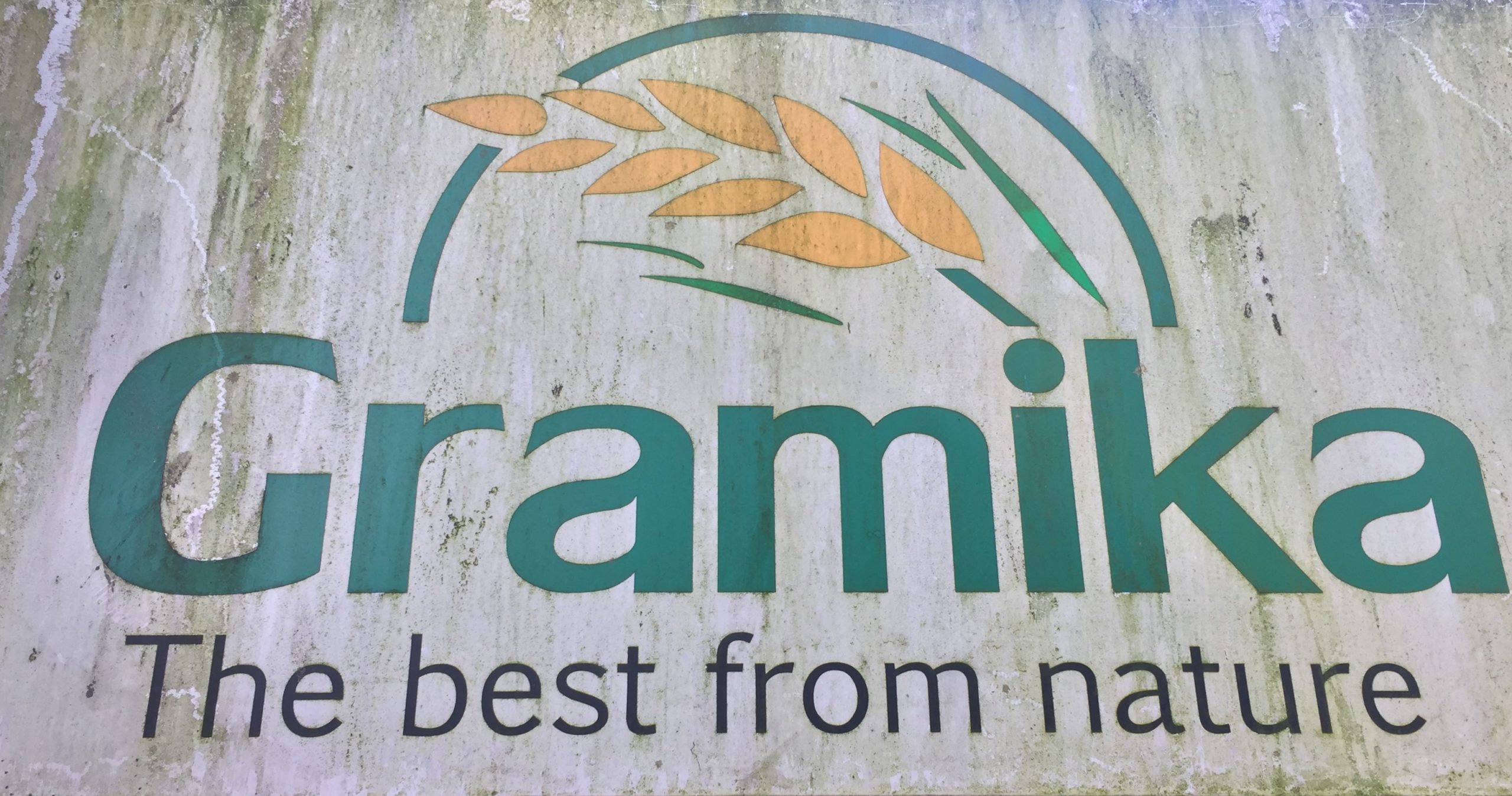
Figure 10: Gramika logo
New initiatives go a step further, including the integration of cage culture of fin fish with pokkali cultivation. The unutilized sluice pit and channels in pokkali fields are used in this method. This approach, pioneered by Krishi Vignan Kendra and the Central Marine Fisheries Institute, would not disturb the traditional pokkali farming system. Projects like these are funded by the National Initiative on Climate Resilient Agriculture (NICRA).[13] [14]
These initiatives could motivate the farmers to continue with this unique system of farming by making sure that they do not have to incur losses. Farmers, as well as consumers, should be educated about initiatives and opportunities like these that can be done through collective action to promote pokkali and thereby build wider awareness and an understanding of its value.
One progressive farmer noted that the key to successfully managing pokkali farming and making it profitable was to reduce the cost of cultivation:
It is not necessary that farmers suffer losses in pokkali cultivation and then make it up through prawn cultivation. There are possibilities of making pokkali cultivation profitable. I started cultivating around a decade ago with 3 acres and now have increased it to 12 hectares. There are several ways to reduce the cost of cultivation.
Firstly, building a fixed sluice (instead of wooden one which needs annual maintenance and replacement over years); secondly, the use of concrete bunds instead of mud bunds; thirdly, the use of pump set for draining the water; fourthly, the timely sowing and transplanting; fifthly, no wastage of yield through proper handling and storage; the mechanisation of threshing/drying processes; sixthly, maintaining the depth of the farmland in such a way as to enable Pokkali farming.
In addition, building sheds/road ways to transport the yield from interiors of the farm; and the promotion of sustainable tourism through home stays during pokkali farming needs to be encouraged. I have also been involved in the production of value added products (the production of popular snack items like kurkure, noodles and vermicelli from pokkali rice have already been piloted).
The key to operationalizing such initiatives, however, is to engage in group farming to minimize costs. Undertaking pokkali cultivation in less than a hectare is not feasible anymore and thus, it is important to federate farmers together and reduce the cost of production. There is also need to integrate pokkali farming with fish culture; not as a system of rotation of paddy with crop. I have seen that it is possible to simultaneously undertake fish culture and paddy since these are wetlands”
Conclusion
Pokkali, the golden colored grain, has led local populations to refer to the farmland or the locale as ‘Kanakam vilayum Kudi’ (the land which produces gold), as one of the women we met during the survey noted:
“Two or three decades ago, it was a matter of pride to marry into a household engaged in pokkali cultivation. The farmlands are referred as those which cultivate gold, given the golden colour of the Pokkali paddy. This place, Kadamakudi, is actually a variant of Kanakakudi or land of gold”.
Kadamakudi, in fact, is one of the panchayats within Ernakulam district which is a prominent area under paddy cultivation even today. [15] In fact, the farmer group which received the Genome Award also hails from this locale. Despite the unique challenges faced today by this unique method of cultivation, concerted practical efforts can help us sustain this traditional farming system and turn it once again into the land that produces gold.
Copyright 2021 Soumya Vinayan and N. Lalitha.
Soumya Vinayan is Assistant Professor at Council for Social Development, Hyderabad, India. Her research interests focus on the issues of sustainability with special emphasis on intellectual property rights, livelihoods, and disability.
N. Lalitha is Professor at Gujarat Institute of Development Research, Ahmedabad, Gujarat, India. She is focusing on understanding the role of Geographical Indications as a tool for rural development in India’s context.
Email: [email protected], [email protected].
This article is drawn from a larger study on Geographical Indications Registered Agricultural Products in Select States of India, and the authors gratefully acknowledge the Indian Council of Social Science Research, New Delhi for the financial support.
Notes
[1]Kerala has three important rice cultivating areas based on the extent of paddy cultivation, traditional varieties cultivated, and traditional farming systems. Mathew K Sebastian, P. A. Aziz, Chaithra Shree Jayasimhan, and P. Arun, “Ecological and Ethno-Cultural Examination of the Rise and Fall of Rice Culture in Southern India with special reference to the Western Ghats”, Final Report submitted to Indira Gandhi National Centre for Arts, New Delhi by Salim Ali Centre for Ornithology and Natural History, Coimbatore. 2015.
[2] Discussion with Prof Shyla Raj at Rice Research Station, Kerala Agricultural University, Vyttilla.
[3] For a detailed account of cultivation practices please see Soumya Vinayan, and N. Lalitha, “Climate Change and Paddy Cultivation: The Relevance of GI tagged Pokkali rice from Kerala”. Paper presented at INSEE-CESS International Conference on “Climate Change and Disasters: Challenges, Opportunities and Responses” held from 6-8 November at Centre for Economic and Social Studies, Hyderabad. 2019.
[4] Women farmer groups we met had pointed out that this unique way of sowing seeds on a mound is inherently different from paddy cultivation in non-wetlands.
[5] Around 35% in 2018 as evident in the study by N. Lalitha, Soumya Vinayan, and B. Madhusudan, “Geographical Indications Protected Agricultural Products from the Select States of India: An Enquiry into the Economic, Livelihood and Institutional Aspects”. Final Report submitted to Indian Council of Social Science Research, New Delhi by Gujarat Institute of Development Research, Ahmedabad and Council for Social Development, Hyderabad. 2020.
[6] K. S. Shylaraj, Soumya G Nadh, and Simmi K Chandran. ‘Comparative Analysis of Grain Quality and Nutraceutical Properties of Selected Rice Varieties from Kerala’, Current Science 114, no 5 (2018): 1088-1094; M.K. Srivastava, “Speciality Rice Varieties of Kerala are Storehouse of Nutrition: Study’, The Hindu Business Line, 23 March 2018. Available at https://www.thehindubusinessline.com/news/science/speciality-rice-varieties-of-kerala-are-storehouse-of-nutrition-study/article23334574.ece, accessed on April 16, 2019.
[7] See Shreeshan Venkatesh, and Rejimon Kuttappan. (2018) “This is why Kerala floods were the worst in a century”, Down To Earth, September 12. (https://www.downtoearth.org.in/coverage/climate-change/this-is-why-kerala-floods-were-the-worst-in-a-century-61491) (Accessed on January 18, 2021).
[8] The last month of Malaylam (calendar – lunar) falls between mid-July to mid-August.
[9] The third month of Malayalam calendar falls between mid-October and mid-November.
[10] See P.T. Dipson, Spatio-temporal changes in the wetland ecosystem of Cochin city using remote sensing and GIS, PhD Thesis submitted to Cochin University of Science and Technology (CUSAT), Cochin. 2012. http://hdl.handle.net/10603/19147, accessed on May 10, 2019; P.R. Jayan and Nithya Sathyanathan. ‘Overview of farming practices in the water-logged areas of Kerala, India’, International Journal of Agricultural and Biological Engineering, 3, no 4 (2010): 28-43. Available at https://www.ijabe.org/index.php/ijabe/article/view/333, accessed on April 15, 2019; and V.R. Deepak, “Development with an ecological perspective focusing on Wetlands of Kadamakudy Panchayat, Kochi”, International Conference on Emerging Trends in Engineering, Science and Technology (ICETEST- 2015), Procedia Technology, 24 (2016): 1691-1698.
https://www.sciencedirect.com/science/article/pii/S2212017316302869 accessed on April 16, 2019.
[11] Agile Joy, “Development Impact on Pokkali Fields: A Case of International Container Transshipment Terminal”, IOSR Journal Of Humanities And Social Science (IOSR-JHSS), 10 no 5 (2013): 1-5. www.iosrjournals.org/iosr-jhss/papers/Vol10issue5/A01050105.pdf?id=6238, accessed on April 16, 2019.
[12] For more details, see Antony P. Kuriakose, “Economic Analysis of Rice based Cropping System in Coastal Agro-Eco System of Kerala Thesis”. Unpublished Ph.D Thesis Submitted to Mahatma Gandhi University, Kottayam in partial fulfillment of the requirements under the Faculty of Social Science. 2015. http://shodhganga.inflibnet.ac.in:8080/jspui/handle/10603/111459 accessed on July 26, 2020; and M. Suchitra, and P. N. Venugopal. “In Troubled Waters”, Down to Earth, 15 December 2015. https://www.downtoearth.org.in/coverage/in-troubled–waters-10519 accessed on January 1, 2019.
[13] M.J. Prabu, “Shrimp, Fish and Paddy cultivation in same field is lucrative”. The Hindu. 6 June 2013.https://www.thehindu.com/news/national/shrimp-fish-and-paddy-cultivation-in-same-field-is-lucrative/article4785499.ece accessed on July 8, 2020.
[14]C Mohanakumaran Nair, K.R. Salin, Devika Pillai, S. Sarath, C.K.Manoj. “Simultaneous rice-fish culture system in modified Pokkali rice fields – a possible alternative to improve sustainability”, In B. Meenakumari, M.R. Boopendranath, Leela Edwin, T.V. Sankar, Nikita Gopal & George Ninan (eds.), Coastal Fishery Resources of India-Conservation and Sustainable Utilisation, Kochi: Society of Fisheries Technologists (India), Central Institute of Fisheries Technology, 2010, pp.59-66.
[15] The data provided by Pokkali Land Development Agency, a Kerala Government agency, which also is the registered proprietor of the GI tag, indicates that while there are around 5900 hectares of Pokkali land available (Ernakulam district accounts for 4055 hectares followed by Alappuzha (977) and Thrissur – 855), the area under cultivation is much lower. In 2018-19, the total area under Pokkali cultivation stood at 995 hectares, of which 604 hectare was in Ernakulam district.
